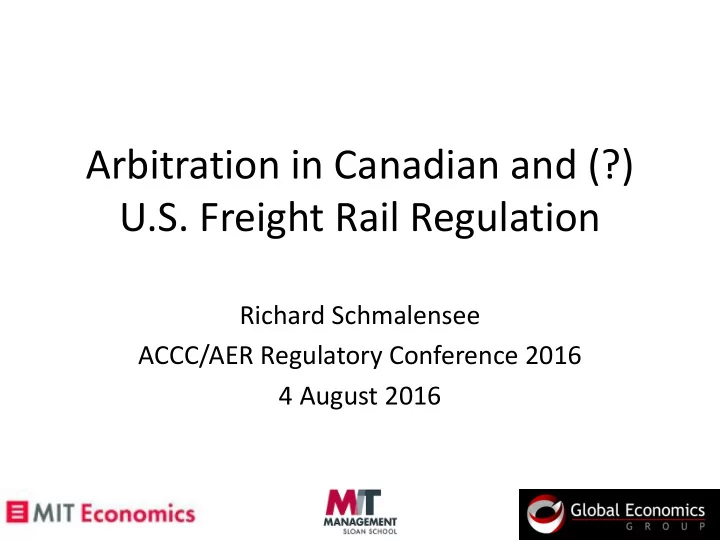

Arbitration in Canadian and (?) U.S. Freight Rail Regulation Richard Schmalensee ACCC/AER Regulatory Conference 2016 4 August 2016
The (Common) Regulated Era • US and Canadian freight railroads have almost always owned the tracks on which they ran • Except for some Canadian roads nationalized after WWI, since privatized, all have been private • Federal control over rates and service in Canada began in 1905, in the US in 1906 • Trucks, buses, and planes were increasingly troublesome after WWI despite protective regulation • Inter-city passenger service was nationalized in the US in 1971, in Canada in 1977
Partial Deregulation in the US • During the 1970s, railroads were increasingly subsidized, some nationalized • The Staggers Act, 1980, deregulated some commodities, allowed negotiated contracts for all others, some protection for shippers using posted tariffs • The hope/expectation was that railroads would use their market power to raise rates enough to survive • Instead, average real rates fell sharply through early 2000s, and service and profits both improved! • Even protective regulators over-constrained the railroads, prevented cost-cutting & modernization
Post-Staggers US Shipper Protection • A US shipper can challenge a rate only if it exceeds 180% of accounting “variable cost” – not a good MC estimate • Must then show it has no competitive alternative • Then generally need to show the rate exceeds cost of a RR built to serve only that shipper. OK for some coal, but… – Alternative tests make even less sense & are little used • Slow, expensive ($5 million US) formal process, useless for small shippers, especially if ship to multiple places • Congress asked National Academies, “Is there a better way?” The Academies answered in 2015.
The Canadian Alternative • Canada deregulated freight from 1967 through 2007; results similar to US • As in US, private contracts are allowed, & shippers can complain about posted rates • Since 1988, complaints have been managed by independent arbitrators with 60-day time limit (30 for small matters) • No restrictions on evidence; shipper need not be captive, but arbitrator must consider competitive alternatives • The arbitrator must choose between the two parties’ final offers; FOA encourages moderate offers
The Canadian Alternative II • Arbitrators’ decisions are not made public; hold for only one year • 1988-2011, only 18 rate challenges brought; compromises are apparently eventually made. • More challenges regarding service quality, which is not regulated in the US • Concerns about this process (mainly from RRs): – Arbitrators may know nothing about railroads – Shippers may ask for and get below-cost rates – No precedent or predictability
A Canadian-Influenced NAS/TRB Proposal • Dump administrative “variable cost” measures, which make no economic sense • Instead, model rates set under rail/water competition as functions of observables (paper being finalized); treat as competitive benchmarks • “Unusually high” rates relative to competitive benchmarks (how to define?) can be challenged • Challenges to be handed to arbitrators to deal with dominance & reasonability issues with strict time limits, no limits on evidence • Use final offer arbitration behind closed doors as in Canada • Shippers like this; RRs behind closed doors mainly worry about definition of “unusually high” • Unfortunately, this reform would require new legislation; not likely in Washington these days…
Recommend
More recommend